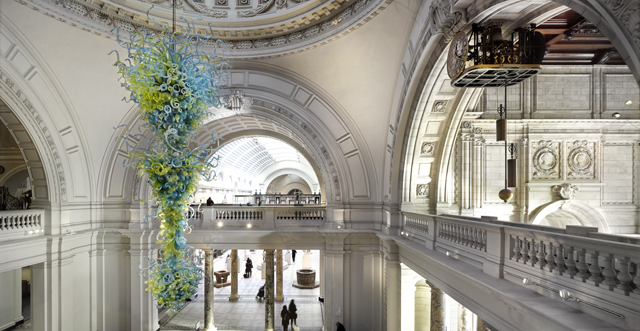Sculptural extravaganzas, three-dimensional souvenirs, talking points: chandeliers are so much more than just light fittings.
Houghton Hall, Norfolk
The minimally furnished Stone Hall at Houghton Hall in Norfolk is ornamented by the splendid giltwood chandelier bought by the 2nd Earl of Orford in 1748 from the sale of the London house of his brother-in-law, the 3rd Earl of Cholmondeley.
Bath Assembly Rooms
The Bath Assembly Rooms are hung with a suite of nine Whitefriars crystal chandeliers, eight the work of William Parker of Fleet Street, the ninth (and, with 48 branches, the largest) by Jonathan Collett. Commissioned in 1771, the Assembly Room chandeliers are among the finest in England and deceptively elegant given their considerable size (each weighs about 440lb).

The White Drawing Room, Buckingham Palace, 1935 (oil on canvas), Richter, Herbert Davis (1874-1955) / Private Collection / Photo © Christie’s Images / Bridgeman Images
Buckingham Palace, London
Suspended from the centre of John Nash’s gilded ceiling in the White Drawing Room at Buckingham Palace, London SW1, is a waterfall chandelier of appropriately regal dimensions.
Dolmabahçe Palace, Istanbul
Even the waterfall chandelier at Buckingham Palace pales alongside the Bohemian crystal chandelier on view in the Ceremonial Hall of Istanbul’s Dolmabahçe Palace. The world’s largest chandelier of its sort, with 750 lights, it weighs 41⁄2 tons and was a gift to Sultan Abdülmecid I from Queen Victoria.
V&A Museum, London
Dale Chihuly’s Rotunda Chandelier in the V&A, London SW7, is a green, blue and yellow, moulded-and blown-glass sculpture, completed in 2001. More than 26ft tall and composed of writhing, wriggling glass forms, it dominates the museum entrance.
Brighton Pavilion
On entering the Banqueting Room of Brighton Royal Pavilion, your eyes are drawn to the domed ceiling and the stupendous chandelier designed by Robert Jones. Made in 1817 at the colossal cost of £5,600 by the London firm of Bailey and Saunders, it measures a staggering 30ft high.










